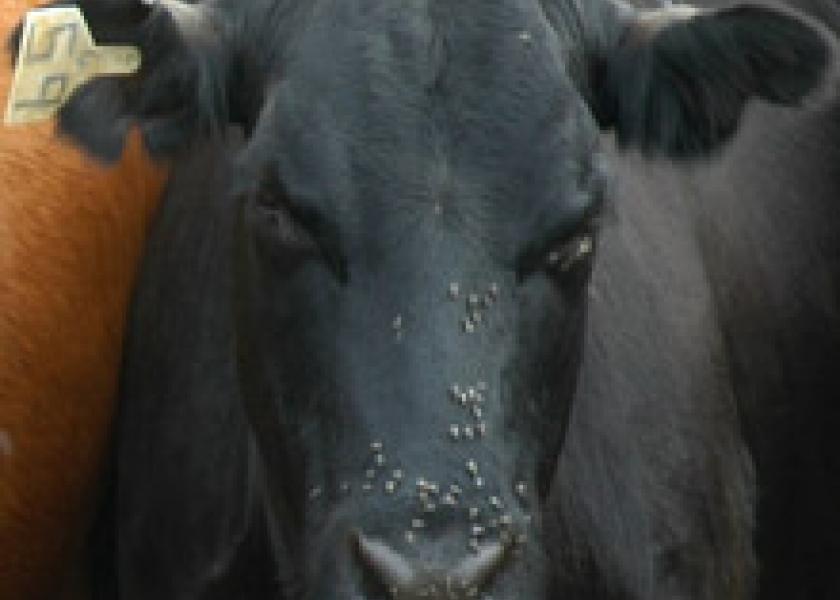Preparing for Fly Season

Keep flies away from your cattle to help increase herd profitability.
By: Lew Strickland, Extension Veterinarian, University of Tennessee
Are Flies Just Pests?
Every cattle farm has ?ies and are considered a nuisance. However, fly infestation reduces performance and certain flies are responsible for spreading diseases such as pink eye and potentially anaplasmosis. To decrease disease risk to your livestock, it is important to understand where ?ies live and breed and the strategic control methods available.
Adult ?ies prefer to lay their eggs in wet organic matter, such as fresh manure and spilled feed. Moisture is needed for the ?y eggs, larvae and pupae to develop. Therefore, controlling moisture is an important step in the reduction of ?y numbers on your farm.
Out With the Waste!
Manure piles are fly breeding heaven, so waste management is critical in creating a fly management program. An average 1,250lb beef cow generates 75lb of manure a day, so manure management is a full-time job!
For some species of flies, the life cycle can be as short as 2 weeks. In order to break the fly life cycle, you need to remove or spread fly breeding materials (manure, wet grain, spilled silage, moist hay, etc.) on a regular basis. Start by removing manure from livestock areas as frequently as possible. Take this manure and spread it thinly on fields or other large outdoor areas to facilitate drying. Also, drag your fields to more evenly distribute manure. Flies cannot develop in dry environments, so spreading manure thinly is the first step in trying to break the fly life cycle.
Pay special attention to areas where your herd congregates, such as water troughs, shady areas and gates. These areas should be cleaned weekly at a minimum to diminish fly breeding and control parasites. Remember, it’s easier and more cost effective to prevent fly breeding than to control adult flies. So the quicker we can remove their habitat, the less likely we are to see these pests.
Keep Them Off!
Feed and mineral mixtures with larvicide in it passes through the cow and the product kills the larvae in the manure so that adults cannot emerge. They are very effective at killing developing ?ies but must be incorporated at least 3 weeks prior to ?y season. Blocks with insect growth regulators (IGR) help to reduce the population of flies and can be used early in the ?y season to delay use of ear tags. Remember, IGR’s do not keep flies off from the animal. They only work to reduce the population of the flies.
Dusters or dust bags that contain insecticide work well for pastured cattle if the animals are forced to pass through them to get to feed, water, or mineral. Monitor the dusters for use; cattle should use them every 2-3 days to be effective. To ensure insecticide is applied to their face, they should be placed low enough so cattle have to drop their heads to go through them. There should be 2 dust bags for every 50-60 animals to ensure every animal has access. With the smaller stature of calves, dusters must be hung at a level that is appropriate. Back rubbers or oilers are similar to dusters; they rely on contact with the insecticide but use an oil solution (diesel fuel #2) instead of dust. There should be 20 feet of contact space for every 50-60 cows to ensure every animal has access. Add insecticide every 2-4 weeks to maintain effectiveness.
Pour-ons or sprays are absorbed by the animal and act to repel ?ies that feed on blood (as well as lice and grubs). They are directly applied to animals and have to be re- applied every 3 weeks in the case of horn ?ies. Pour-ons are more labor intensive than some other options listed here.
Impregnated ear tags can provide many weeks of protection against ?ies. Fly tags generally provide coverage for 12-15 weeks. The most appropriate time to begin using fly tags is when fly numbers reach greater than 50 flies per animal. Contact your local extension agent for recommendations in your area.
Spring will be a good time to initiate fly control in cows and calves. In most years in Tennessee this occurs in May. An integrated approach that includes feed through IGR blocks, back rubs, dust bags, spray and pour-ons and ear tags is often the most effective when used in this order. Current research suggests using only one class of insecticide (pyrethroid or organophosphate) in all of the products used during a single season. Rotating classes of insecticides every 1-2 years prolongs the effect of each and reduces the risk of developing resistance in the fly population. Also, be sure to remove fly tags at the end of the fly season.
Other classes of active ingredients are now available to help with resistance in flies. Spinosyn, and avermectin impregnated ear tags are available to use if pyrethroid or organophosphate tags are ineffective. Work with your Extension agent or veterinarian to make an informed decision on which should work best in your area.







